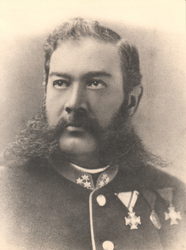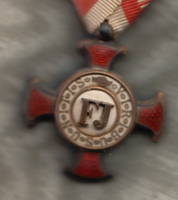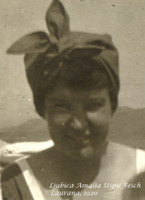Informazioni ottenute presso l'Archivio Militare Austroungarico di Vienna
 Franc Stipić nasce a Carlstadt (Karlovac, 56 km a sudovest di Zagabria, Croazia) il 12 settembre 1835. Figlio di borghesi (Bürgersohn), il 12 marzo 1849, all’età di 14 anni, entra nell’esercito austriaco come “Expropriis Gemein” (nota 1) nel 4° reggimento di fanteria Sluiner, di stanza in Croazia, ai confini orientali.
Franc Stipić nasce a Carlstadt (Karlovac, 56 km a sudovest di Zagabria, Croazia) il 12 settembre 1835. Figlio di borghesi (Bürgersohn), il 12 marzo 1849, all’età di 14 anni, entra nell’esercito austriaco come “Expropriis Gemein” (nota 1) nel 4° reggimento di fanteria Sluiner, di stanza in Croazia, ai confini orientali.
E’ di religione cattolica, ha occhi e capelli castani, altezza m1,70 (67 Zoll - nota 7), parla croato, tedesco e italiano. Segue un corso triennale nella scuola (Unter-Realschule) militare di scienze matematiche di Turn (nota 2) con buon successo.
Dopo cinque anni (1854) viene nominato sottotenente (Leutnant 2. Klasse), iniziando così la carriera di ufficiale, che proseguirà fino al grado di comandante di compagnia (Hauptmann 1. Klasse, nel 1877).
Nel 1859, a 24 anni, è nelle retroguardie nella campagna contro l’esercito franco-sardo a Melegnano (nota 3), poi partecipa alla battaglia di Solferino (nota 4),  il 24 giugno dello stesso anno (seconda Guerra d’Indipendenza). Per il suo valoroso comportamento in battaglia gli viene assegnata la croce al merito (Verdienstkreuze (nota 5)).
il 24 giugno dello stesso anno (seconda Guerra d’Indipendenza). Per il suo valoroso comportamento in battaglia gli viene assegnata la croce al merito (Verdienstkreuze (nota 5)).
Nel 1866, a 31 anni, è nuovamente in Italia (terza Guerra d’Indipendenza) ma non partecipa ai combattimenti.
Nel 1878 ha 43 anni e combatte a in Bosnia, a Šamac e a Gradačac (nota 6) come comandante di Compagnia.
Pensionato all’età di 45 anni, dal 1 maggio 1880, con anzianità 35 anni e con una pensione di invalidità di 1.050 fiorini annuali.

L’anno dopo, il 31 maggio 1883 nasce sua figlia Ljubica Amalia Maria Clotilde che più tardi sposerà Reginald Fesch.
Il 1 gennaio 1886 nasce il figlio Richard, a Pregrada. Il 25 novembre 1888 la seconda figlia Katharina Maria Franziska, che però muore l’anno dopo, l’8 dicembre 1890. Il 14 dicembre 1891 nasce la terza figlia, Stephanie Antonia a Praga.
Muore a Pregrada, all’età di 60 anni, il 13 gennaio 1895.
Note
(1) Alla carriera militare potevano accedere di norma solamente i figli di militari, che entravano come cadetti, oppure figli di civili, che entravano con la qualifica di “Expropriis Gemein”. Questi ultimi dovevano provvedere al proprio corredo ed alla propria attrezzatura com “mezzi propri”.
(3) Austro-Hungarian Army Campaign Calendars
Throughout the latter half of the nineteenth century the forces of Austria were involved in numerous external wars and additionally were involved in the rebellions in Hungary, the Northern Italian provinces and police actions in the Balkans. At the conclusion of a particular round of hostilities the Ministry of War would publish a Circular Order or Circular-Verordnung which listed all the official battles, engagements, skirmishes etc with their associated dates. These events, places and dates were then taken into official use for all future historical reporting and submissions for awards and decorations. A table providing the translations of the terms used in the individual lists is found below.
1848 Campaign in Italy
1848 Campaign in Hungary
1849 Campaign in Italy
1849 Campaign in Hungary
1859 Campaign in Italy
1864 Campaign in Schleswig and Jütland (Denmark)
1866 Campaign in Bohemia and South Germany
1866 Campaign in Italy
1869 Insurrection in South Dalmatia
1878 Campaign in Bosnia-Herzegovina
1882 Insurrection in Bosnia-Herzegovina and South Dalmatia
(4) La Battaglia di Solferino (24 giugno 1859) venne combattuta fra l'esercito austriaco e quello franco-sardo e concluse la seconda guerra d'indipendenza. Insieme alla Battaglia di San Martino fu la più grande battaglia dopo quella di Lipsia del 1813, avendovi partecipato complessivamente più di 200.000 soldati.
Dopo la sconfitta a Magenta, l'esercito austriaco si ritirava verso est. Lo stesso Francesco Giuseppe venne personalmente in Italia per prendere il comando delle truppe, rimuovendo dall'incarico il generale Gyulai, considerato colpevole della sconfitta.
La battaglia di Solferino e San Martino fu la più lunga (dalle 12 alle 14 ore di combattimento) e la più sanguinosa combattuta per l'indipendenza e l'unità d'Italia. Gli austriaci persero 14000 uomini e 8000 vennero presi prigionieri, i franco-sardi 15000 e 2000 prigionieri; questa carneficina sembra aver indotto Napoleone III a firmare l'armistizio a Villafranca, con questo atto concludendo di fatto la seconda guerra d'indipendenza. L'Austria fu costretta a cedere la Lombardia, eccetto Mantova, a Napoleone III, che come da accordi, la girò al regno di Sardegna. Testimone d'eccezione della battaglia fu Henry Dunant ideatore, promulgatore e primo segretario della Croce Rossa.
On his 25th jubilee in December 1873 Kaiser Franz Joseph I. instituted a so-called "Kriegsmedaille" (War-Medal). The medal shows on the obverse side the Kaiser's head surrounded by a laurel wreath and on the reverse side the date "2.December 1873" (those showing the spelling Dezember where produced after 1900). It was suspended from a ribbon with the Habsburg-colors black and yellow! The medal was given to all personnel who took part in a minimum of one action since 1848. Later this medal was also given to all personnel who took part in each completed campaign until the Kaiser's death in November 1916. Beside this general war service medal there was only one medal instituted for a single campaign. This was the "Erinnerungsmedaille an den Feldzug 1864 gegen Dänemark" (Denmark-War-Medal). This small medal was introduced jointly by the Austrian Kaiser and the Prussian King and was made from the bronze alloy of the cannons captured in the Danish fortress Friedericia. The medal was given to all men of the German Austrian forces who were engaged in this particular war. The reverse shows the words "UNSEREN TAPFEREN KRIEGERN 1864" (to our brave warriers 1864) and the obverse side shows the crowned initials of the Austrian Kaiser (FJ) and the Prussian King (W). The ribbon show the colors of both countries. The Austrians received the medals with the "FJ" on the left and a yellow/black/white ribbon and the Germans received it with the "W" on the left and a white/black/yellow ribbon."
(6) Bosanski Šamac: The city was part of the old Ottoman province of Bosnia by the time it was incorporated in the Austro-Hungarian Empire at the end of 19th century. After the I World War, the city passed to part of the Kingdom of Yugoslavia. From 1929 to 1939, it was part of Drina Banovina; and from 1939 until 1941 it was part of the Banovina of Croatia. During World War II, Bosanski Šamac, as all the rest of Bosnia-Herzegovina, was included into Nazi-controlled Independent State of Croatia. After 1945, the city was reintegrated within the Socialist Republic of Bosnia and Herzegovina in Tito’s Yugoslavia.
The town lies on an important strategic position – the corridor connecting north-western and south-eastern parts of Republika Srpska, near Brcko and bordering the two FBiH’s exclaves at the frontier with Croatia. As with most other places under their control, Srpska authorities removed the “Bosnian” adjective from the town’s official name. Bosniaks and Croats continue to refer to it as “Bosanski Šamac”.
Gradačac (Cyrillic: Градачац) is a town and municipality in the northeastern part of Bosnia and Herzegovina, located roughly 40 km south of the Sava river. Administratively, Gradačac is part of the Tuzla Canton of the Federation of Bosnia and Herzegovina. The towns of Bosanski Šamac and Modriča lie near Gradačac.
In the census of 1991, the municipality of Gradačac had 56,378 residents of which there were: 60.2% Bosniaks, 19.8% Serbs, 15.1% Croats, and 4.9% others.
The župa of Gradačac was first mentioned in 1302, while the town's first written mention dates from 1465 (also as Gračac). The town became part of the Ottoman Empire in 1512, its nahija (municipality) was first recorded in the defter of 1533, while its kadiluk (county) was recorded in 1634.
In 1701 the settlement was given the status of a palanka (city), and it became the headquarters of a military captaincy in 1710. The captains of the Gradaščević family led the development of the city, and the most famous of them, Husein-kapetan Gradaščević or Zmaj od Bosne ("Dragon of Bosnia"), led an uprising that raised to arms most of the Bosnian captains in 1831.
The town has a fort with 18-meter high walls built between 1765 and 1821, and a 22-meter high watchtower, built in 1824 by the Ottoman empire on foundations made originally by the Romans.
According to the 1910 population census, the majority in the district was held by Orthodox Serbs - 35.90%. Gradačac became part of the Tuzla Canton in the Federation of Bosnia and Herzegovina after the war.
(7) Unità di misura nell'impero Austroungarico
| Punkt | = | 182,917 037 | µm | ||||||||||
| Linie | = | 12 | Punkte | = | 2,195 004 | mm | |||||||
| Zoll | = | 144 | Punkte | = | 12 | Linien | = | = | 26,340 053 | mm | |||
| Faust | = | 576 | Punkte | = | 48 | Linien | = | 4 | Zoll | = | 105,360 213 | mm | |
| Fuß | = | 1728 | Punkte | = | 144 | Linien | = | 12 | Zoll | = | 316,080 640 | mm | |
| Klafter | = | 6 | Fuß | = | 1,896 483 840 | m | |||||||
| Rute | = | 10 | Fuß | = | 3,160 806 400 | m | |||||||
| Meile | = | 24000 | Fuß | = | 4000 | Klafter | = | 2400 | Ruten | = | 7,585 935 360 | km |